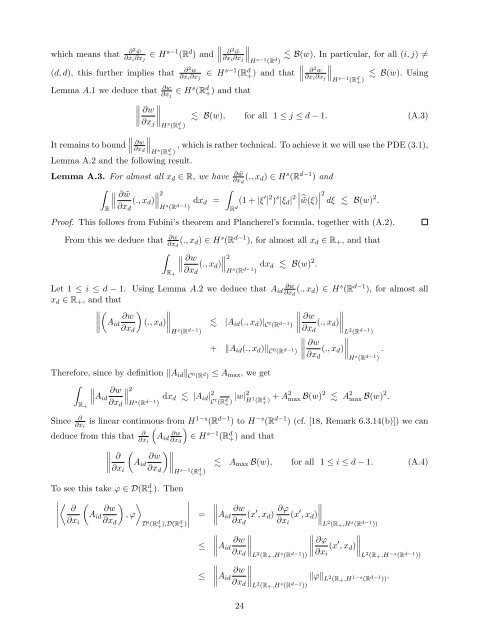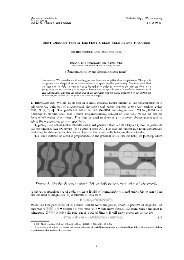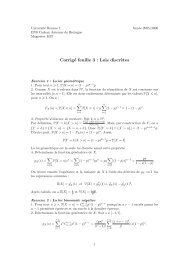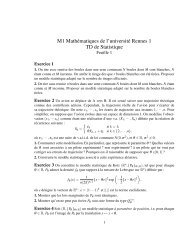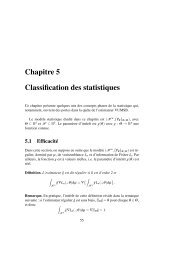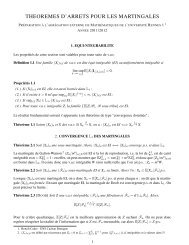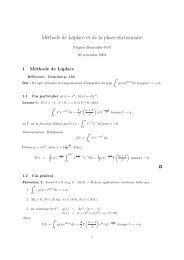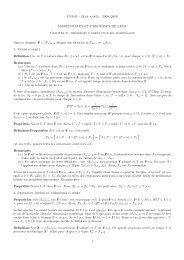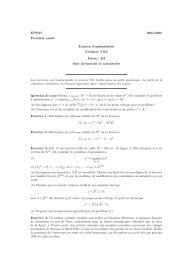Bath Institute For Complex Systems - ENS de Cachan - Antenne de ...
Bath Institute For Complex Systems - ENS de Cachan - Antenne de ...
Bath Institute For Complex Systems - ENS de Cachan - Antenne de ...
Create successful ePaper yourself
Turn your PDF publications into a flip-book with our unique Google optimized e-Paper software.
∥∂which means that2 ˜w∂x i ∂x j∈ H s−1 (R d ) and ∥ ∂2 ˜w ∥∥H∂x i ∂x j B(w). In particular, for all (i, j) ≠s−1 (R d ) ∥∂(d, d), this further implies that2 w∂x i ∂x j∈ H s−1 (R d +) and that ∥ ∂2 w ∥∥H∂x i ∂x j B(w). Usings−1 (R d + )Lemma A.1 we <strong>de</strong>duce that ∂w∂x j∈ H s (R d +) and that∥ ∂w ∥∥∥H∥ B(w), for all 1 ≤ j ≤ d − 1. (A.3)∂x j s (R d + )∥ It remains to bound ∥ ∂w ∥∥H∂x d, which is rather technical. To achieve it we will use the PDE (3.1),s (R d + )Lemma A.2 and the following result.Lemma A.3. <strong>For</strong> almost all x d ∈ R, we have ∂ ˜w∂x d(., x d ) ∈ H s (R d−1 ) and∫∥ ∂ ˜w∫(., x d ) ∥ 2 ∣ R ∂x dx d H s (R d−1 d = (1 + |ξ ′ | 2 ) s |ξ d | 2 ∣∣̂˜w(ξ) ∣ 2 dξ B(w) 2 .) R dProof. This follows from Fubini’s theorem and Plancherel’s formula, together with (A.2).From this we <strong>de</strong>duce that ∂w∂x d(., x d ) ∈ H s (R d−1 ), for almost all x d ∈ R + , and that∫ ∥ ∥∥ ∂w(., x d ) ∥ 2R +∂x dx d H s (R d−1 d B(w) 2 .)∂wLet 1 ≤ i ≤ d − 1. Using Lemma A.2 we <strong>de</strong>duce that A id ∂x d(., x d ) ∈ H s (R d−1 ), for almost allx d ∈ R + , and that( )∂w∥ A id (., x d )∂x d∥ |A id (., x d )| C ∂wt (R d−1 ) ∥ (., x d )H s (R d−1 )∂x d∥L 2 (R d−1 )+ ‖A id (., x d )‖ C ∂w0 (R d−1 ) ∥ (., x d ) ∥ .∂x d∥H s (R d−1 )Therefore, since by <strong>de</strong>finition ‖A id ‖ C 0 (R d ) ≤ A max , we get∫ ∥ ∥∥Aid ∂w∥ ∥∥2R +∂x dx d H s (R d−1 d |A id | 2) C t (R d + ) |w|2 H 1 (R d + ) + A2 max B(w) 2 A 2 max B(w) 2 .∂∂x iSince is linear continuous from H 1−s (R d−1 ) to H −s (R d−1 ) (cf. [18, Remark 6.3.14(b)]) we can( )∂ ∂w<strong>de</strong>duce from this that∂x iA id ∂x d∈ H s−1 (R d +) and that( )∥ ∂ ∂w ∥∥∥H∥ A id A max B(w), for all 1 ≤ i ≤ d − 1. (A.4)∂x i ∂x d s−1 (R d + )To see this take ϕ ∈ D(R d +). Then〈 ( ) 〉∣ ∂ ∂w∣∣∣∣ A∣id , ϕ=∂x i ∂x d D ′ (R d + ),D(Rd + )≤≤∥ A ∂wid (x ′ , x d ) ∂ϕ(x ′ , x d ) ∥∂x d ∂x i ∥ ∥ A ∂w ∥∥∥L ∂ϕid∂x d∥ (x ′ , x d ) ∥2 (R + ,H s (R d−1 ))∂x i ∥ ∥ A ∂w ∥∥∥Lid∂x d 2 (R + ,H s (R d−1 ))∥L 2 (R + ,H s (R d−1 ))∥L 2 (R + ,H −s (R d−1 ))‖ϕ‖ L 2 (R + ,H 1−s (R d−1 )).24


